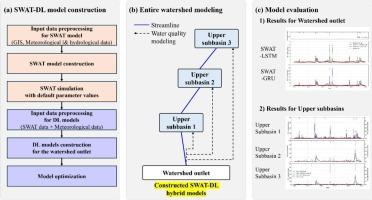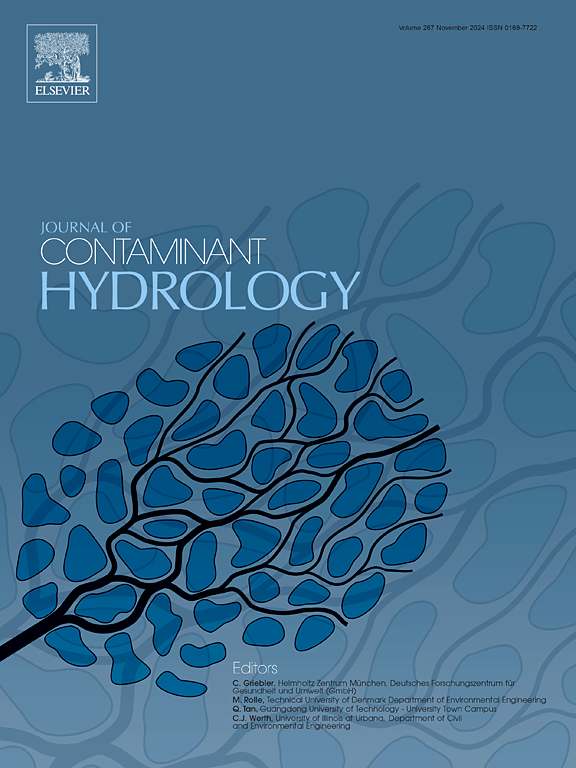评价水土评价工具-深度学习混合模型在混合农业流域总氮负荷预测中的适用性
IF 4.4
3区 环境科学与生态学
Q2 ENVIRONMENTAL SCIENCES
引用次数: 0
摘要
土壤和水评估工具(SWAT)是一种广泛使用的基于过程的流域模型,用于模拟不同土地利用和气候条件下的水文和水质。其性能在很大程度上依赖于有效的校准和验证,以实现准确的参数化。然而,这些过程往往是耗时的,并受到相当大的不确定性。为了解决传统单点校准的空间局限性,引入了多点校准,但它仍然是资源密集型的,并且可能导致子盆地之间的不一致性。为了克服这些挑战,本研究提出了swat -深度学习(DL)混合模型来预测混合农业流域的总氮(TN)负荷。具体来说,目的是评估使用未校准SWAT输出在流域出口处训练的DL模型是否可以有效地推广到上游子流域,从而绕过校准的需要。利用未校准的SWAT模拟和降水数据,构建了SWAT- long - short - Memory (LSTM)和SWAT- gated Recurrent Unit (GRU)两个混合模型。两种混合模型的表现都优于多地点校准的SWAT模型。SWAT-LSTM模式在捕获降雨期间TN峰值方面表现出更高的敏感性,而SWAT-GRU模式在峰值后和恢复期间提供了更稳定的预测。特征重要性分析进一步揭示了对水文和水质变量的明显依赖。此外,SWAT- dl混合框架产生了巨大的实用优势,在保持高精度的同时,实现了比多站点SWAT校准计算效率提高十倍以上。通过减少校准需求而不影响准确性和可转移性,这种混合方法代表了流域尺度水质建模的可扩展和资源高效替代方案。本文章由计算机程序翻译,如有差异,请以英文原文为准。

Assessing the applicability of the soil and water assessment tool–deep learning hybrid model for predicting total nitrogen loads in a mixed agricultural watershed
Soil and Water Assessment Tool (SWAT) is a widely used process-based watershed model for simulating hydrology and water quality under varying land use and climate conditions. Its performance relies heavily on effective calibration and validation to achieve accurate parameterization. However, these processes are often time-consuming and subject to considerable uncertainty. Multi-site calibration has been introduced to address the spatial limitations of conventional single-site calibration, yet it remains resource-intensive and may introduce inconsistencies among subbasins. To overcome these challenges, this study proposes SWAT-deep learning (DL) hybrid models for predicting total nitrogen (TN) loads in a mixed agricultural watershed. Specifically, the objective was to evaluate whether DL models trained at the watershed outlet using uncalibrated SWAT outputs could generalize effectively to upstream subbasins, thereby bypassing the need for calibration. Two hybrid models, SWAT-Long Short-Term Memory (LSTM) and SWAT-Gated Recurrent Unit (GRU), were constructed using uncalibrated SWAT simulations and precipitation data. Both hybrid models consistently outperformed the multi-site calibrated SWAT model. The SWAT-LSTM model demonstrated higher sensitivity in capturing sharp TN peaks during rainfall events, whereas the SWAT-GRU model provided more stable predictions across post-peak and recovery periods. Feature importance analysis further revealed distinct dependencies on hydrological and water quality variables. In addition, the SWAT-DL hybrid framework yielded a substantial practical advantage, achieving a more than a tenfold gain in computational efficiency over multi-site SWAT calibration while sustaining high accuracy. By reducing calibration demands without compromising accuracy and transferability, this hybrid approach represents a scalable and resource-efficient alternative for watershed-scale water quality modeling.
求助全文
通过发布文献求助,成功后即可免费获取论文全文。
去求助
来源期刊

Journal of contaminant hydrology
环境科学-地球科学综合
CiteScore
6.80
自引率
2.80%
发文量
129
审稿时长
68 days
期刊介绍:
The Journal of Contaminant Hydrology is an international journal publishing scientific articles pertaining to the contamination of subsurface water resources. Emphasis is placed on investigations of the physical, chemical, and biological processes influencing the behavior and fate of organic and inorganic contaminants in the unsaturated (vadose) and saturated (groundwater) zones, as well as at groundwater-surface water interfaces. The ecological impacts of contaminants transported both from and to aquifers are of interest. Articles on contamination of surface water only, without a link to groundwater, are out of the scope. Broad latitude is allowed in identifying contaminants of interest, and include legacy and emerging pollutants, nutrients, nanoparticles, pathogenic microorganisms (e.g., bacteria, viruses, protozoa), microplastics, and various constituents associated with energy production (e.g., methane, carbon dioxide, hydrogen sulfide).
The journal''s scope embraces a wide range of topics including: experimental investigations of contaminant sorption, diffusion, transformation, volatilization and transport in the surface and subsurface; characterization of soil and aquifer properties only as they influence contaminant behavior; development and testing of mathematical models of contaminant behaviour; innovative techniques for restoration of contaminated sites; development of new tools or techniques for monitoring the extent of soil and groundwater contamination; transformation of contaminants in the hyporheic zone; effects of contaminants traversing the hyporheic zone on surface water and groundwater ecosystems; subsurface carbon sequestration and/or turnover; and migration of fluids associated with energy production into groundwater.
 求助内容:
求助内容: 应助结果提醒方式:
应助结果提醒方式:


